Jewelry ecommerce will grow to $75 billion in 2024. Learn the strategies that can ensure you get a piece of the pie.
Here, you’ll find:
- 11 jewelry ecommerce marketing strategy ideas
- How to start a jewelry business online
- Examples of the best jewelry ecommerce websites
- What’s the best ecommerce platform for jewelry?
- Common challenges for jewelry ecommerce business owners
- How to leverage jewelry ecommerce trends
In 2024, the online jewelry market is valued at an estimated $75 billion. By 2027, it’s projected to reach a value of $115 billion. With such a steep growth trajectory, jewelry ecommerce has plenty of potential for creative entrepreneurs.
Considering launching your own jewelry line or growing your existing brand online? We’ll cover everything you need to get started, including ecommerce platforms, marketing strategies, and trends and challenges online jewelry retailers should know.
11 jewelry ecommerce marketing strategy ideas
Which channels should your jewelry ecommerce strategy include? What tactics should you prioritize? Use these ideas to develop your ecommerce marketing plan.
- Search engine optimization (SEO)
- Social media marketing
- Email marketing
- Influencer marketing
- Customer testimonials
- Product giveaways
- Jewelry quizzes
- Customer loyalty programs
- Search ads
- Shopping ads
- Social ads
1. Search engine optimization (SEO)
Optimizing your website for search helps customers find your jewelry easier. Do keyword research to find relevant search terms potential customers use to find products like yours.
Then incorporate those keywords into product descriptions, blog posts, and other locations across your website. Use SEO with content marketing to rank for target keywords related to your business.
2. Social media marketing
Marketing your business with social media platforms like Instagram, Facebook, and Pinterest can attract an organic following and build a community of happy customers.
Here are a few ideas to inspire you.
Pretty Perfect Style uses Instagram reels to share interviews with the jewelry designer and create a connection with followers.
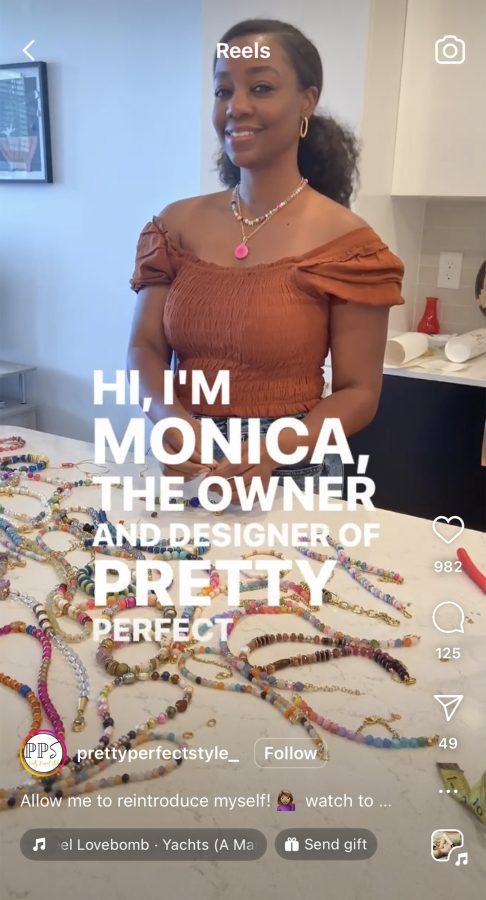
By Hand and By Heart uses Instagram’s reminder feature to announce upcoming product drops and generate excitement.
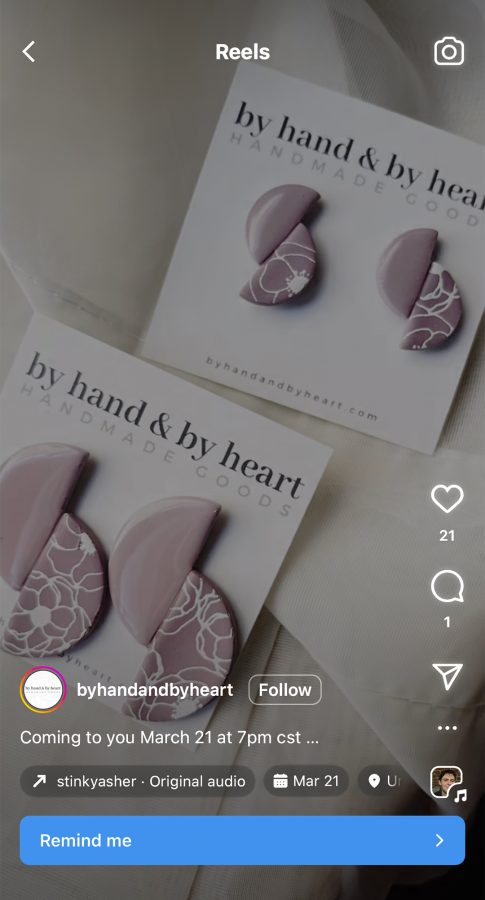
Olive and Piper shares customer stories on the brand’s Instagram highlights as a way to thank customers and share social proof.
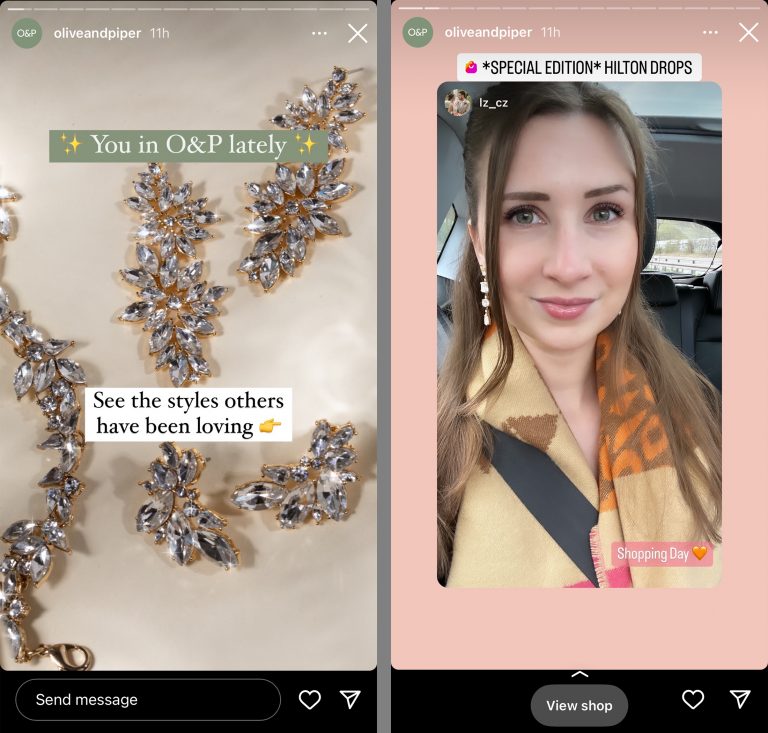
“For our ecommerce business, social media has been the most successful marketing channel,” shares Sergey Taver, marketing manager at Precision Watches. “We’ve seen a significant increase in engagement and conversions through platforms like Instagram and Facebook, particularly when we use high-quality images and storytelling.”
One campaign involved a series of posts highlighting the craftsmanship behind the brand’s watches, which resulted in a 25% increase in traffic and a 15% increase in sales over a month.
3. Email marketing
Email marketing connects you with customers directly. It’s a smart channel for ecommerce businesses since email has an average return on investment of $36 to $40.
Offer new subscribers an incentive to build an email list. For example, Elaine B Jewelry gives customers $50 off their first order just for signing up for its email list.
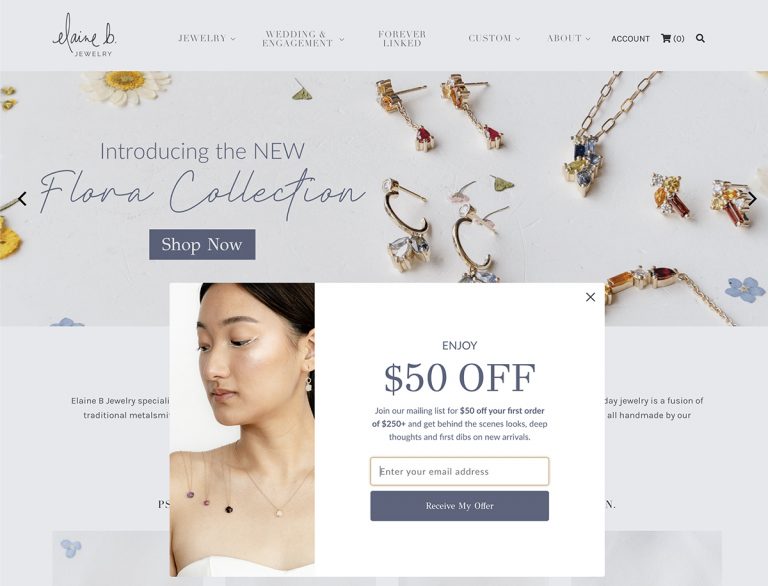
4. Influencer marketing
Influencer marketing gives you the chance to reach customers outside of your current audience. When you partner with influencers, they introduce your brand to their followers — who may become your customers, too.
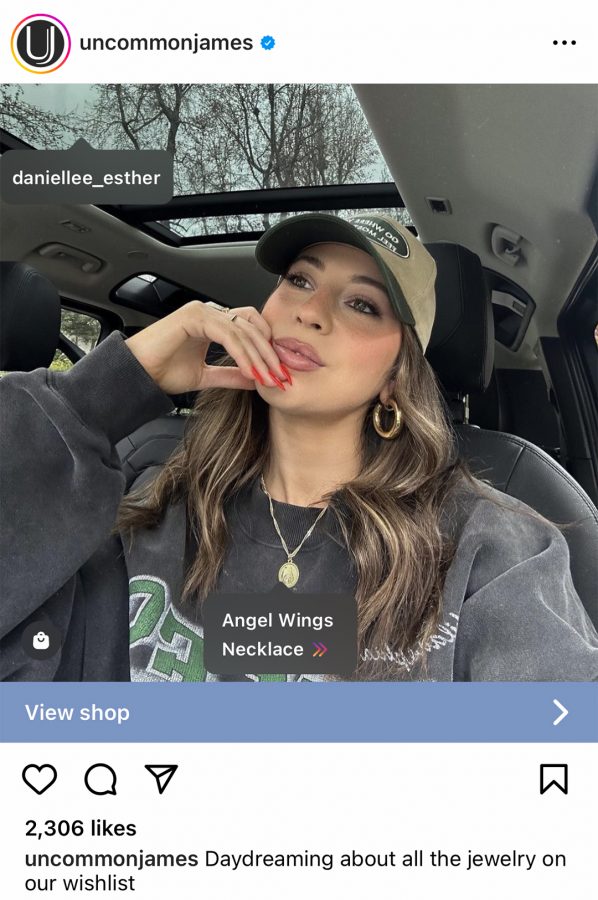
Above, Uncommon James partners with Instagram influencer Danielle Esther. Below, Melinda Maria Jewelry’s Instagram post features a celebrity influencer, Eva Longoria.

5. Customer testimonials
When you feature reviews and testimonials on your website or social media channels, you let customers speak for your brand. A testimonial like the Instagram post by Yellow Nest Goods below offers social proof, which can convert new customers.
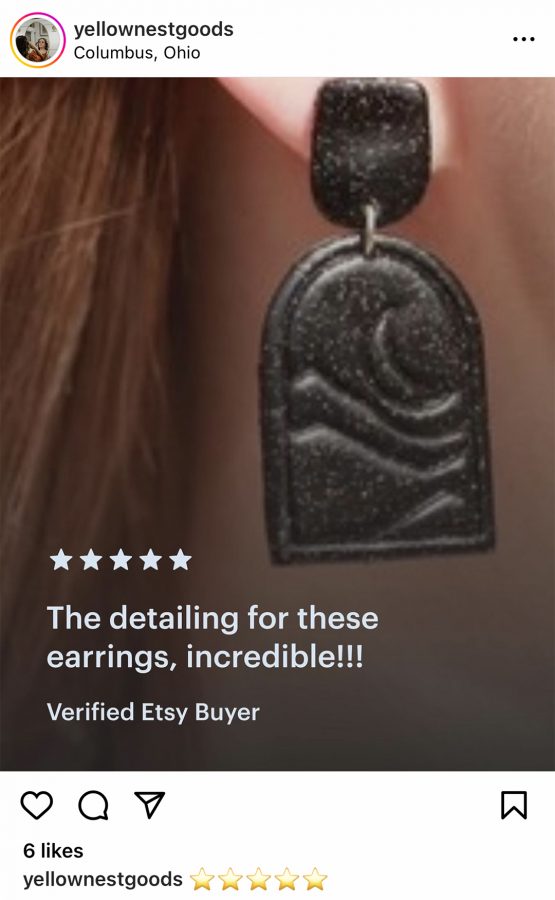
6. Product giveaways
Product giveaways encourage potential customers to follow your brand on social media for a chance to win a jewelry item. Events like the Instagram giveaway by Minted Mire below can generate significant buzz for an ecommerce jewelry brand.

7. Jewelry quizzes
“One hack we found is when you post about your products you also share a link to a product recommendation quiz so they can find the best variant of that product (or collection of products) for them,” shares Gabriel A. Mays, Co-Founder and CEO of POPSMASH.
It gives you access to customer contact information and drives discovery at the same time, Mays explains. You can then use this data to send these customers personalized messaging.
“In general, you’ll see a 30% opt-in rate, meaning 30% of those who comment on the post (e.g. on Instagram) will also take the quiz, so you’ll get preference + contact data from those for future marketing, which converts really well.”
8. Customer loyalty programs
Loyalty programs incentivize repeat purchases, which can improve sales and create a community of happy customers. Below, Judith Bright offers a program that rewards loyal customers for purchases, reviews, and social media posts. Shoppers can redeem rewards for discounts on future purchases.

9. Search ads
You don’t have to rely solely on organic marketing to promote your business. You can reach a wider audience and drive more sales when you choose the right ecommerce ad platform.
Google search ads are one option for online jewelry businesses. Sponsored search results, like the Purpose Jewelry ad below, can appear when customers search for terms relevant to your business.
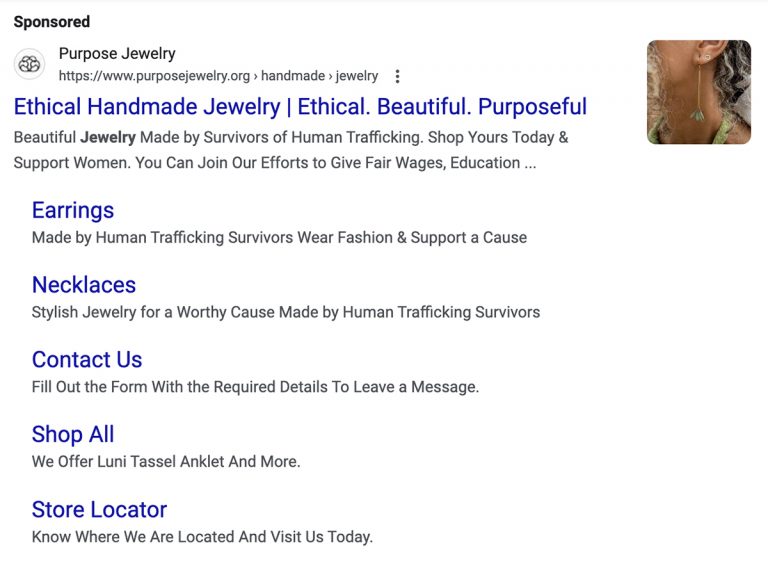
10. Shopping ads
Google Shopping ads also appear in search results, but close to the top of the page. Shopping ads like the examples below are optimized for clicks and sales. Along with product images, they display information like the product name, brand name, product price, and ratings or shipping details.

11. Social ads
Sponsored social posts can run on Facebook, Instagram, Pinterest, or any other social media platform. To drive results, follow the lead of the Love Stylize Instagram ad below, and mention a time-sensitive discount code in the ad copy.

“Our most successful marketing channel has been a combination of Google Shopping campaigns and social media advertising, particularly on Facebook and Instagram,” shares Joosep Seitam, Co-founder of Icecartel.
“We’ve seen a significant increase in engagement and conversion rates, with our latest campaign yielding a 30% increase in click-through rates and a 25% boost in sales compared to the previous quarter.”
How to start a jewelry business online
Have a great idea for an online jewelry business? Begin with a jewelry ecommerce business plan to get clear on your concept, then research the market, and determine how profitable it’s likely to be.
Here are the steps to take to jumpstart your online jewelry business.
Do market research
Analyze the online jewelry market even if you already have a detailed concept in mind. This will tell you how saturated certain niches are so you can focus on one where you’re likely to succeed.
It’ll also tell you what competitors are doing so you can differentiate your business effectively. Pay attention to how competitors market their jewelry lines and make a note of what appears to work — and what doesn’t.
Choose a niche
Decide on a niche for your business after the initial research. Think about what makes you unique. For example, you could focus on your:
- Designs: Whether you focus on minimalist or maximalist designs, make sure your jewelry has a look that customers can’t find anywhere else.
- Functionality: Do your necklaces, bracelets, and rings have a practical purpose like holding secrets, changing color with your mood, or creating a sense of calm?
- Sourcing: Have you found a way to source high-quality or rare materials? Focusing on sustainable or local sources can set you apart from the competition.
- Location: The location of your jewelry studio can attract local customers or shoppers in your area, even if you only sell online.
Determine pricing
Next, crunch the numbers to price your jewelry line appropriately. Set a price point that earns you a profit and makes sense for your target audience. To find that sweet spot, consider the cost of:
- Materials, which may fluctuate over time
- Labor, including the time you and your team spend producing the jewelry
- Space, including studio and warehouse space
- Marketing, including an advertising budget
Jewelry ecommerce design businesses have an average gross profit margin between 50% and 70%. Your gross profit could range from $5,000 to $7,000 if your online store brings in $10,000 in monthly revenue.
Examples of the best jewelry ecommerce websites
Looking for inspiration? Check out some of the best ecommerce jewelry sites to get ideas for your online store.
Satomi Kawakita

Satoma Kawakita specializes in fine jewelry, including wedding rings and one-of-a-kind gifts. On the designer’s website, customers can shop these two collections, browse the gift guide, or book services at the brick-and-mortar store.
Hello Adorn

Hello Adorn designs handmade jewelry at affordable prices. Some of the designer’s items belong to small collections or limited drops, which creates a sense of urgency or a fear of missing out (FOMO).
Oak and Luna
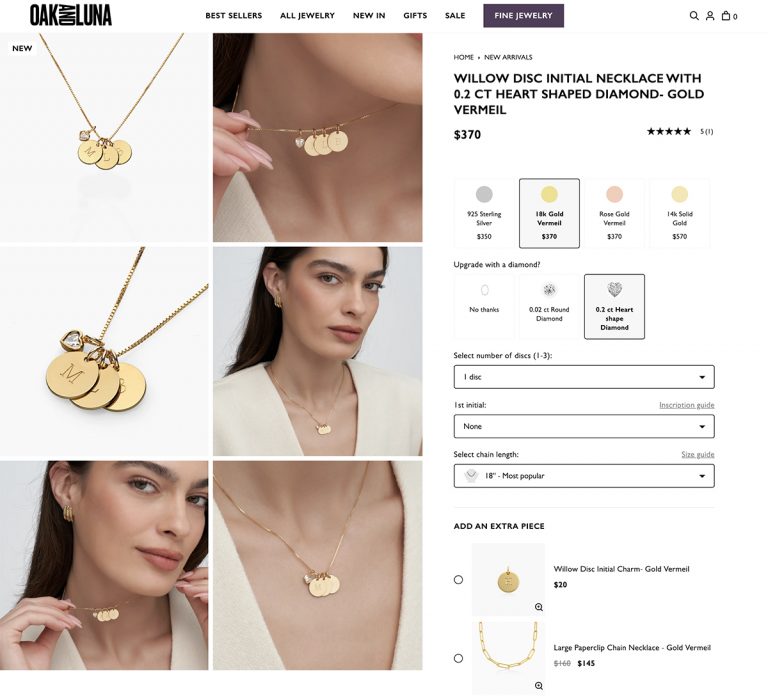
Oak and Luna specializes in custom jewelry that customers can easily personalize for themselves or as gifts. Each jewelry product page includes options like precious metal types, gemstone upgrades, chain lengths, and custom initials.
Kenda Kist
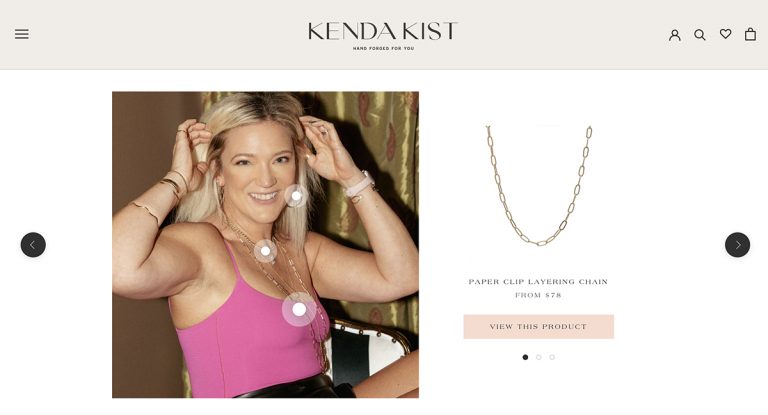
Kenda Kist makes hand-forged jewelry with gemstones and precious metals. On the designer’s website, customers can tap to shop items featured in product images, which also provide styling suggestions.
J. Mills Studio

J. Mills Studio produces modern handmade jewelry that customers can purchase online or at the designer’s studio. The website features customer reviews that serve as social proof and a sales driver.
What’s the best ecommerce platform for jewelry?
You need the right website platform to build a successful jewelry brand. These website builders offer the best inventory management for sellers and online shopping experiences for customers.
Shopify
Shopify is the ecommerce website builder of choice for millions of merchants around the world. It has an affordable basic tier for new sellers, Shopify Plus for digital brands seeking to scale, and an Enterprise solution for large businesses with a global footprint.
One of the biggest perks of using Shopify is its wide range of integrations. For example, it syncs with Facebook and Instagram so you can set up a social media shop or run ads for more visibility.
BigCommerce
BigCommerce is another popular ecommerce website builder that’s ideal for small businesses and enterprise companies. Its essentials solution lets you build a responsive site with search engine optimization (SEO), and its enterprise solution offers the flexibility and speed large businesses need to scale.
Like Shopify, BigCommerce integrates with many sales and advertising platforms. For example, it syncs with Amazon so you can sell on both platforms simultaneously.
Adobe Commerce
Adobe Commerce, formerly Magento, is an ecommerce platform that lets you create online stores for multiple brands. Its AI and personalization technology are great for creating custom experiences for shoppers and efficient promotions for sellers.
Adobe Commerce is part of the Adobe ecosystem. That means Adobe Commerce users can leverage tools like Adobe Analytics for website analytics and Adobe Journey Optimizer for custom user journeys.
Squarespace
Squarespace is a smart solution if you’re looking for a simpler solution that’s easy for a first-time online business owner to set up. You can choose from one of the platform’s premade design templates, input your jewelry pieces, and start selling with minimal setup.
Use Squarespace’s built-in tools to market your ecommerce business. For example, the platform offers advanced optimization tools to improve visibility and email marketing tools to build your list.
Etsy
The ecommerce platforms above give you complete control over your inventory and how you run your business. The downside is that customers won’t find your website if you don’t market your business using some of the strategies below.
In contrast, Etsy has a built-in discovery engine. Customers can find your listed jewelry through the platform’s search tools or on-site ads.
That said, Etsy has potential downsides — it charges fees for listing items and other essential sales activities in its online marketplace.
Amazon
Like Etsy, Amazon is an online marketplace. Amazon customers place 12.1 million orders per day on average, making this one of the largest marketplaces of its kind. With Amazon PPC ads, you can reach customers actively searching for the jewelry you sell.
One potential downside of selling via this platform is the fees, as Amazon charges either per item or per month. However, one major perk is you can sell on Amazon without a website, which saves you time and hassle. You also have the option to set up your website and sync the inventory with your Amazon store.
Common challenges for jewelry ecommerce business owners
As lucrative as this industry can be, selling jewelry online comes with its fair share of challenges. Prepare for these potential issues to avoid slowing your growth.
- Fluctuating commodity prices
- Evolving customer preferences
- Competition with physical stores
- Attribution and user journey tracking
Fluctuating commodity prices
You can’t always expect consistent costs when you use precious metals and gemstones in jewelry designs. For example, the cost of gold has fluctuated wildly over the past year alone.
So, how can you set appropriate prices and avoid losing money? As a jeweler, you always have the option to set adjustable prices. If you prefer to set consistent prices, consider establishing a partnership with a gemstone or precious metal supplier.
This way, you get more control over your costs and can worry less about supply chain disruptions.
Evolving customer preferences
You must innovate constantly to succeed in the jewelry industry,. Last year’s designs may become less desirable over time. Plus, developing new designs can keep customers coming back.
As a result, you constantly have to think one step ahead. As soon as you launch your current collection, take steps to start brainstorming the next collection to stay relevant and keep up the momentum.
Competition with physical stores
When you launch a jewelry ecommerce business, your competition includes both other online jewelry sellers and physical stores. So, how do you compete with brick-and-mortar jewelry stores?
Here are a couple of ideas:
- Make it easy for customers to shop on your website or social channels. Remove any friction from the checkout experience so customers can easily act on purchase decisions.
- Offer discounts or special incentives for shopping online. Discount codes and loyalty programs can be particularly helpful for ecommerce businesses.
Remember, ecommerce stores have several advantages over physical shops. For example, online businesses tend to be more cost-effective since there’s no need to rent retail space. As a result, you may be able to charge lower prices.
In addition, online jewelry stores that ship nationwide can market to a larger potential customer base. Once you zero in on your target market, you can reach them via SEO, social media, digital advertising, and other channels.
Attribution and user journey tracking
You have the potential to reach a wider audience when you promote your business across multiple channels. Yet it’s challenging to track the results and attribute them to the correct channel.
That’s why we recommend working with an expert who’s experienced with ecommerce SEO, organic and paid social media, and ecommerce conversion rate optimization. When you partner with an ecommerce marketing agency, you’ll get access to the team, tools, and strategies you need to succeed.
At HawkSEM, we believe that tracking is a critical part of any ecommerce campaign. We use our own proprietary tool, ConversionIQ (CIQ), to track each step of the buyer’s journey across channels. That way, we can identify what’s working — and we can apply these insights to improve results and the customer experience across channels.
So, how effective can omnichannel analytics and managed ecommerce marketing be? By using HawkSEM’s PPC services for e-commerce companies, 686 increased search engine marketing revenue by 562% year over year.
How to leverage jewelry ecommerce trends
When you’re open to new technology, you can jump on trends before other ecommerce jewelry stores do. This way, you can continue to set your brand apart from the competition and grow your business.
Jewelry subscriptions
Want to give customers an added incentive to make another purchase? Rather than selling them a single piece of jewelry, invite them to purchase a subscription.
Jewelry subscriptions can last for a quarter, a year, or another time period. Each month, send subscribers a jewelry piece they can’t purchase individually on your website.
Social shopping
When you market jewelry designs on platforms like Facebook and Instagram, you give customers an easy way to purchase. These platforms have social shopping features that allow customers to browse and buy without clicking away.
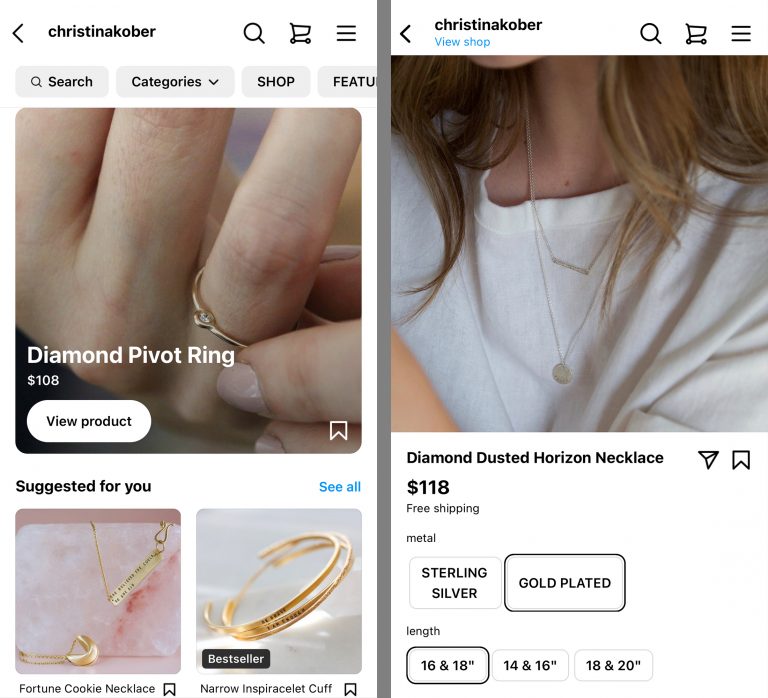
Above, customers can view jewelry by Christina Kober by tapping the “Shop” button on the jeweler’s Instagram profile. Customers can then browse and customize items and tap to buy.
Augmented reality (AR) tools
Great product photos help potential customers envision how your designs would look on them. But you don’t have to leave it up to their imagination.
Many jewelers use AR tools that allow customers to try on designs virtually. By adding a virtual experience to your website, you can help customers see how your necklaces, earrings, and other designs would look with specific outfits.
“AR has been a game-changer for us, especially in providing a try-before-you-buy experience. Our integration of AR technology has led to a 200% growth in e-commerce sales,” explains Seitam. “It has also significantly reduced return rates, as customers can visualize how the jewelry looks on them before making a purchase.”
The takeaway
You need more than unique designs and a novel concept to build a successful business. You also need a marketing strategy that attracts new customers and encourages repeat purchases.
We’re here to help. Contact HawkSEM for a free consultation and learn how a tailored digital marketing strategy can elevate your jewelry ecommerce business.



